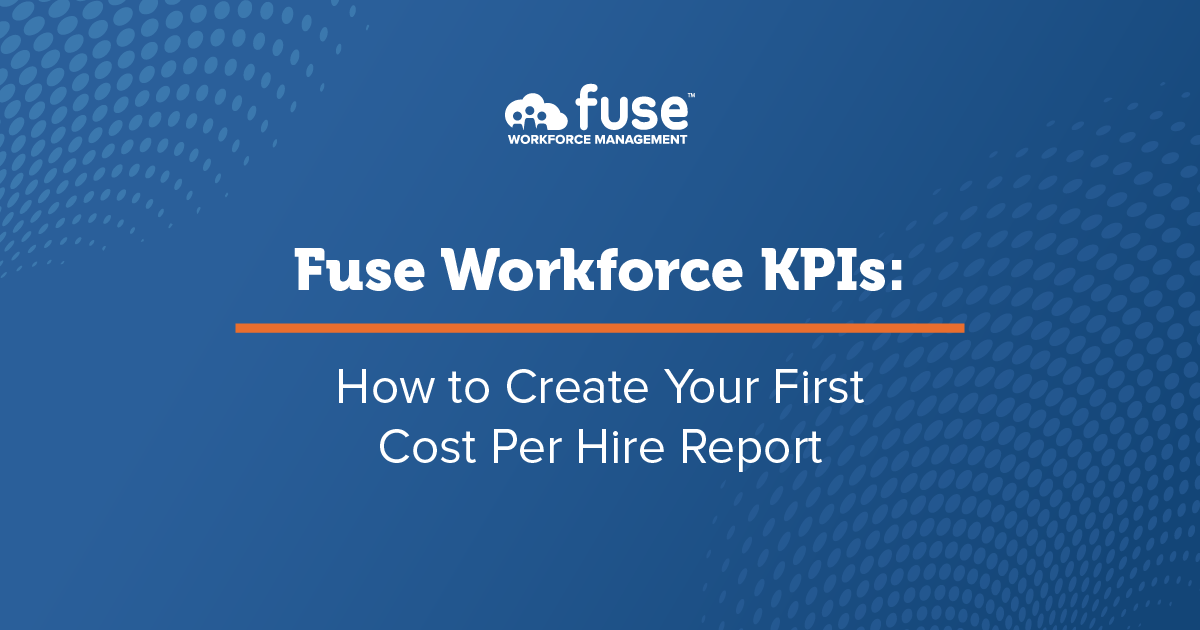While understanding what it costs to hire an employee has always been important, as we look at shifting markets and employee mobility, this metric has taken on new importance. In fact, cost per hire, or CPH, is one of the most commonly used human resource reports.
Cost per hire is a talent analytics measurement that has been used by human resources professionals for decades. Understanding CPH helps to establish hiring and recruiting budgets, and shows how effective a company’s recruiting and staffing process is.

The Value of Understanding Hiring Costs
Hiring can come with many costs. Apart from the salary costs of new candidates, it also costs money to post on job boards, review resumes, and run background checks.
These costs need to be understood so they can be included in each year’s budget. For example, if you understand that it costs $2,000 to hire a candidate on average, and you know that your company needs to hire 20 people, $40,000 will have to be worked into the budget.
However, those are just examples – the actual cost to hire is typically much more. Zippia reports that the current average cost to hire is more than $4,000 and if you’re hiring an executive, it could be more than $15,000. So, as you can see, knowing what to realistically expect is critical.
By using a system to map and keep track of these costs, hiring teams can focus on recruiting and hiring top candidates that will improve company performance.
Who Gets the Most Value from a Cost Per Hire Report?
Human resources and finance teams will find this data most helpful, as it will enable them to optimize the process and manage costs associated with hiring. The data from a CPH report also helps hiring managers to understand the cost of hiring and reinforces the goal of only hiring talent who really fit the role, even if it may take a little longer than is sometimes comfortable. A bad hire is a costly waste of time and resources for everyone.
Understanding Recruiting Costs
Recruiting costs are both internal and external.
Internal costs include
- Applicant tracking system software
- Fixed costs like offices and utilities
- Internal referral program bonuses for employees
- Interview costs based on the hours it takes to prepare and complete an interview
- Internal talent recruitment salaries, benefits, and salaries.
External costs include
- Fees for outside recruiters or agencies
- Recruitment-focused marketing items and giveaways
- Advertising on job boards, websites, and other media
- Candidate assessments and background checks
- Relocation expenses for new hires
Ways to Create a Cost to Hire Report
For many human resources departments, this is a manual process. Someone would input equations to calculate costs into a spreadsheet and then spend many hours formatting the spreadsheet and calculations. Because it’s a manual process, a great deal of extra time is devoted to double-checking equations or explaining the spreadsheet to others. And, of course, anytime someone is using a spreadsheet and manually inputting numbers, there is a great deal of room for error.
The better, and more accurate, choice is to use an applicant tracking system to improve the process. Using such a system takes much of the administrative burden off HR departments and allows them to focus on perfecting processes. It also allows the finance team to cut back on the time it takes to organize these metrics, and the data will be more reliable.
The HR team would no longer need to spend hours creating or maintaining spreadsheets (or having to explain to someone else how to use them.) Instead, those who need hiring data can just pull information from a shared database and view it using built-in comprehensive charts and graphs or export it to a spreadsheet for review.
What You Need for Your First Cost to Hire Report
The most simple CPH is to take all the expenses related to hiring, internal and external, and divide it by the number of hires made in a set time period.
Expenses / hires = CPH
However, that’s a pretty vague approach to the subject, so you will likely want to narrow your target. In today’s data-driven business environment, it will be more specific metrics that matter.
For example, you may want to use only expenses for the executive search, or for a specific department’s new hires. This data becomes more useful in showing differences and similarities between hiring processes, job titles, roles, and any other relevant information, such as whether it costs more to hire someone with a specific skill set than with a different skill set. Or, how much was spent on in-person interviews vs virtual interviews (or even just scheduling interviews), and whether one seemed to be more successful than the other. And, of course, where candidates are coming from - what sources are giving you the most return on your investment.
Ultimately, this information is necessary to identify what’s successful and also show areas where improvements may be needed.
As you can see, knowing how to calculate cost per hire isn’t very complicated, but it can quickly get that way when you want more granular data. This is where it’s helpful to have an applicant tracking system to help collect and manage more detailed reports.

Key Data Used in Cost per Hire Reporting
When tracking data to understand CPH, these are areas where having a solid software system in place will save time, money, and reduce the stress associated with hiring.
Job boards fees
The Fuse Workforce system has a very comprehensive job requisition tool that allows teams to track budgeted jobs and job posting costs. Having a job available in many places will cut back on the amount of time it takes to fill the position, which can greatly reduce the costs associated with hiring.
Anyone who’s been responsible for job posting knows how time-consuming it can be. Recognizing the time that job posting and updating can take, Fuse Workforce includes a free Indeed.com integration that posts each job seamlessly to Indeed within 24 hours of creation. In addition, the free eQuest tool will help jobs find even more candidates, as it posts each job to thousands of free job boards.
Candidate assessment costs
Picking the right candidate for the offer is no small task, and often someone other than the hiring manager will want to know about the best prospects for a role. Fuse Workforce provides many in-depth reports to help assess candidates, allowing recruiters to get a high-level overview of all the candidates.
Once the perfect candidate has been found, the company could use Fuse Workforce to run background check reports and view costs. The online application alone will save countless hours by allowing recruiters to review a report of candidates instead of sorting through emails or printed resumes.
Recruiter expenses
Fuse Workforce can be configured to keep track of money spent to pay individual recruiters, recruiting agencies, or staffing firms. You can also use the system to keep track of the time your recruiters spend reviewing resumes/interviewing candidates for certain jobs.
Careers page costs
Careers pages are a great asset for any company – as long as they’re updated regularly. If website maintenance is not a person’s main role, it can be something that’s easily forgotten. Fuse Workforce makes it very easy to keep content up to date without any additional work. Once you add the redirect link to your company website, created job requirements will post there automatically going forward. This feature cuts back on maintenance costs for your company website – no need to spend time checking the site each week to determine which jobs need to be removed or updated, the system will do that for you.
A Software Product like Fuse Workforce Makes Hiring Easier
A Capterra survey of HR professionals found that 75 percent rely on software to track recruiting activity, and of those, 94 percent say the software has improved their hiring process.
While there are standard metrics used in most cost per hire reports, every company’s needs are a little different. During the implementation process, the Fuse Workforce implementation team will configure the system to meet each client’s needs.
We create the initial reports as well and then teach users how to view the data and make updates. Fuse Workforce provides a user-friendly, easy-to-find learning management tool that allows teams to create their own reports.
When you have all the information you need easily available, you can be more prepared to compete for the best talent for your company and meet your hiring goals.

